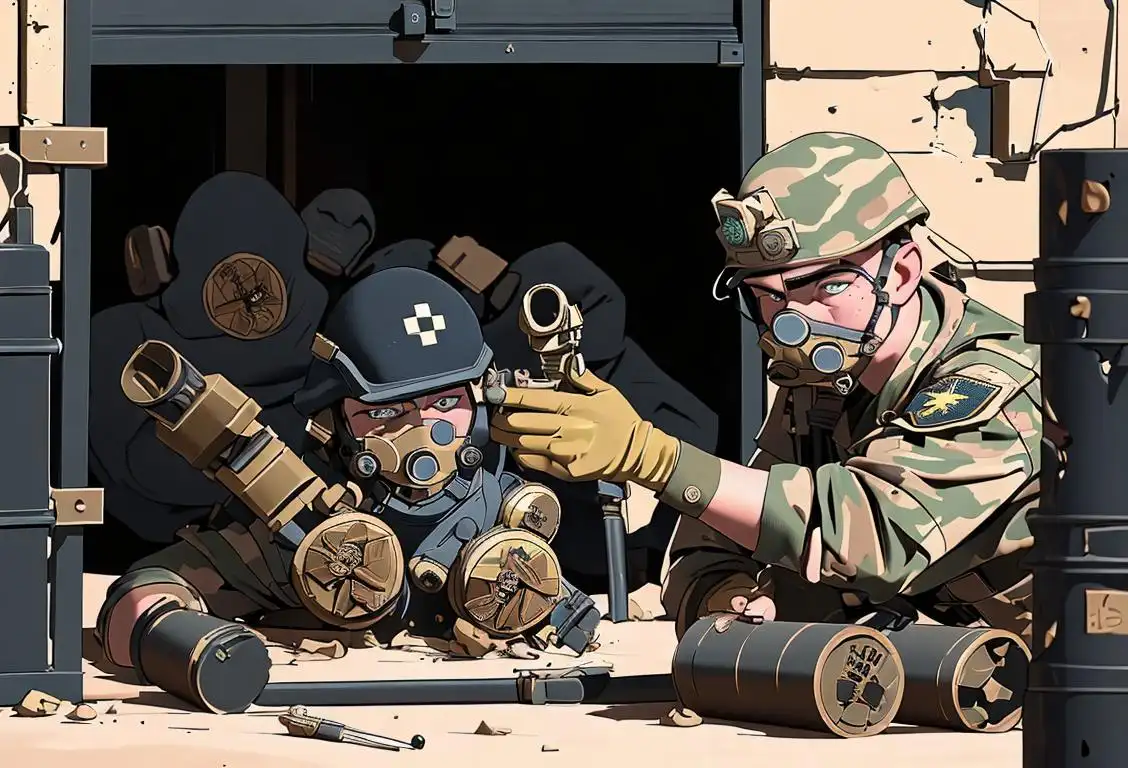National Explosive Ordnance Disposal Day

Happy National Explosive Ordnance Disposal Day! Today, we celebrate the brave men and women who risk their lives to keep us safe from dangerous explosives. From bomb squads to disposal experts, these unsung heroes deserve our gratitude and admiration. So, let's dive into the fascinating world of explosive ordnance disposal and learn more about this important day!
When is Explosive Ordnance Disposal Day?
It's national explosive ordnance disposal day on the 7th May.
The Explosive World of Ordnance Disposal
Imagine being faced with a ticking time bomb, knowing that one wrong move could have catastrophic consequences. That's just another day in the life of an explosive ordnance disposal expert. These fearless individuals work tirelessly to neutralize and safely dispose of explosive devices, ensuring the safety of the public and our brave military personnel.
Explosive ordnance disposal (EOD) has a long and storied history, dating back to World War II. The increased use of explosive weapons during the war necessitated the creation of specialized teams to handle the growing threat. Over the years, EOD techniques and technology have evolved, resulting in highly skilled professionals and advanced equipment.
Recognizing the Unsung Heroes
National Explosive Ordnance Disposal Day is a time to honor and appreciate the dedication and skill of these unsung heroes. It's an opportunity for us to recognize the sacrifices they make and the dangers they face in the line of duty.
Throughout the day, various events and ceremonies take place to raise awareness about explosive ordnance disposal and the vital role it plays in keeping us safe. From educational workshops to demonstrations of EOD techniques, these activities give the public a glimpse into the challenging world of bomb disposal.
But while we celebrate National Explosive Ordnance Disposal Day, it's important to remember that the work of EOD teams goes on every single day. They are always ready to respond to emergencies and protect us from potential threats. So, the next time you come across a news article about an explosives-related incident, take a moment to appreciate the brave men and women who put their lives on the line to keep us safe.
History behind the term 'Explosive Ordnance Disposal'
1940
World War II EOD development
During World War II, the term 'explosive ordnance disposal' (EOD) first appeared. It was used to describe the work of specialized teams tasked with locating, disarming, and disposing of explosive weapons. These teams played a crucial role in neutralizing bombs, mines, and other dangerous munitions to protect military personnel and civilians from harm.
1949
Official recognition of EOD
The military significance and effectiveness of EOD became increasingly evident, leading to its official recognition. In 1949, the United States Armed Forces established its first official school for EOD training. This marked a significant step towards establishing EOD as a recognized and specialized field within the military.
1960s
Introduction of robots in EOD
In the 1960s, advancements in technology led to the introduction of remote-controlled robots in the field of EOD. These robots allowed technicians to approach and disable explosive ordnance from a safer distance, reducing the risk of injury or fatality. The incorporation of robots revolutionized EOD operations and improved the overall safety of EOD technicians.
1970s
Formation of international EOD collaboration
Recognizing the global need for expertise in explosive ordnance disposal, various countries established international collaborations and partnerships in the 1970s. These collaborations aimed to share knowledge, techniques, and best practices in EOD to enhance the effectiveness and safety of operations worldwide. The formation of these alliances facilitated a more coordinated and efficient approach in dealing with explosive threats.
1995
The Ottawa Treaty banning landmines
In 1995, the Ottawa Treaty, officially known as the Mine Ban Treaty, was adopted. This international treaty comprehensively prohibited the use, production, stockpiling, and transfer of anti-personnel landmines. It aimed to eliminate the devastating impact of landmines on civilians and communities. The treaty further emphasized the importance of EOD in clearing and disposing of landmines to ensure a safer environment for civilians.
Present
Continued advancements in EOD technology
EOD technology continues to advance rapidly, enabling more efficient and safer disposal of explosive ordnance. Innovations such as robotic systems, advanced explosives detection equipment, and protective gear have transformed the way EOD technicians operate. These advancements have significantly reduced the risks associated with handling dangerous munitions, allowing for more effective neutralization and disposal methods.
Did you know?
Did you know that explosive ordnance disposal experts undergo rigorous training that includes learning about various types of explosives, bomb detection techniques, and specialized equipment operation? They truly are the superheroes of bomb disposal!Tagged
awareness fun rememberanceFirst identified
2nd May 2015Most mentioned on
7th May 2016Total mentions
76Other days
Voters Day
Unemployed Day
Suicide Prevention Day
Cancer Survivors Day
Memorial Day
Bestfriends Day
Heroes Day
Liberation Day
Pumpkin Day
Gymnastics Day









